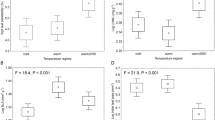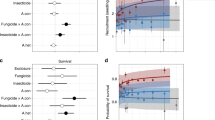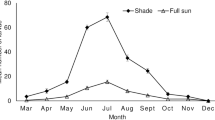Abstract
In highly seasonal environments (for example, temperate deciduous forest or tropical dry forest) plant phenologies are often constrained by physiological stress caused by seasonal variation in temperature and moisture1. Where climatic fluctuations are less pronounced (for example, tropical marine or lowland wet forest communities) determinants of phenology may include biotic selective pressures such as herbivores, predators, competitors, pollinators or dispersers. Temporal patterns of leaf production vary considerably between tropical forest species, but few species produce leaves continuously throughout the year2. Even in aseasonal tropical forests, most species show synchronous peaks in leaf production2. Results from this one-year study suggest that herbivores may influence leaf phenology of shade-tolerant understory plants in a Panamanian lowland moist forest. Leaves produced during the dry season or in synchronous flushes receive significantly less damage from herbivores than leaves produced during the wet season or out of synchrony with conspecifics.
This is a preview of subscription content, access via your institution
Access options
Subscribe to this journal
Receive 51 print issues and online access
$199.00 per year
only $3.90 per issue
Buy this article
- Purchase on Springer Link
- Instant access to full article PDF
Prices may be subject to local taxes which are calculated during checkout
Similar content being viewed by others
References
Larcher, W. Physiological Plant Ecology (Springer, Berlin, 1980).
Richards, P. W. The Tropical Rain Forest (Cambridge Univ. Press, Cambridge, 1952).
Coley, P. D., Bryant, J. P. & Chapin, III, F. S. Science 230, 895–899 (1985).
Rosenthal, G. A. & Janzen, D. J. Herbivores: Their Interaction with Secondary Plant Metabolites (Academic, New York, 1979).
Crawley, M. J. Herbivory: the Dynamics of Animal-Plant Interactions (Univ. California Press, Berkeley, 1983).
Coley, P. D. Ecol. Mongr. 53, 209–223 (1983).
Feeny, P. Rec. Adv. Phytochem. 10, 1–40 (1976).
McKey, D. in Herbivores: Their Interaction with Secondary Plant Metabolites (eds Rosenthal, G. A. & Janzen, D. H.) 55–133 (Academic, New York, 1979).
Mattson, W. J. Jr A. Rev. Ecol. Syst. 11, 119–161 (1980).
Scriber, J. M. & Slansky, F. Jr A. Rev. Ent. 26, 183–211 (1981).
Lieberman, D. & Lieberman, M. Biotropica 16, 193–201 (1984).
Crawley, M. J. in Plant Ecology (ed. Crawley, M. J.) 253–290 (Blackwell, Oxford, 1986).
McKey, D. in Proc. XIV Int. Botanical Congress (eds Greuber, W. & Zimmer, B.) (Koeltz, Königstein, 1988).
Rockwood, L. L. Ecology 55, 142–148 (1974).
Croat, T. B. Flora of Barro Colorado Island (Standford Press, Standford, 1978).
Leigh, E. G. Jr, Rand, A. S. & Windsor, D. M. The Ecology of a Tropical Forest: Seasonal Rhythms and Long-term Changes (Smithsonian Inst. Press, Washington, 1982).
Rundel, P. W. & Becker, P. F. Rev. Biol. Trop. 35 (Suppl. 1), 71–84 (1987).
Wolda, H. J. anim. Ecol. 47, 369–381 (1978).
Borcher, R. Ecology 61, 1065–1074 (1984).
Reich, P. B. & Borcher, R. J. Ecol. 72, 61–74 (1984).
Barbour, M. G., Burk, J. H. & Pitts, W. D. Terrestrial Plant Ecology (Benjamin/Cummings, Menlo Park, 1987).
Rathcke, B. & Lacey, E. P. A. Rev. Ecol. Syst. 16, 179–214 (1985).
Coley, P. D. Nature 284, 545–546 (1980).
Author information
Authors and Affiliations
Rights and permissions
About this article
Cite this article
Aide, T. Herbivory as a selective agent on the timing of leaf production in a tropical understory community. Nature 336, 574–575 (1988). https://doi.org/10.1038/336574a0
Received:
Accepted:
Issue Date:
DOI: https://doi.org/10.1038/336574a0
This article is cited by
-
Forest fragmentation impacts the seasonality of Amazonian evergreen canopies
Nature Communications (2022)
-
Consequences of interspecific variation in defenses and herbivore host choice for the ecology and evolution of Inga, a speciose rainforest tree
Oecologia (2018)
-
Diverse patterns of stored water use among saplings in seasonally dry tropical forests
Oecologia (2015)
-
Leaf synchrony and insect herbivory among tropical tree habitat specialists
Plant Ecology (2014)
-
Herbivore-induced resource sequestration in plants: why bother?
Oecologia (2011)
Comments
By submitting a comment you agree to abide by our Terms and Community Guidelines. If you find something abusive or that does not comply with our terms or guidelines please flag it as inappropriate.



